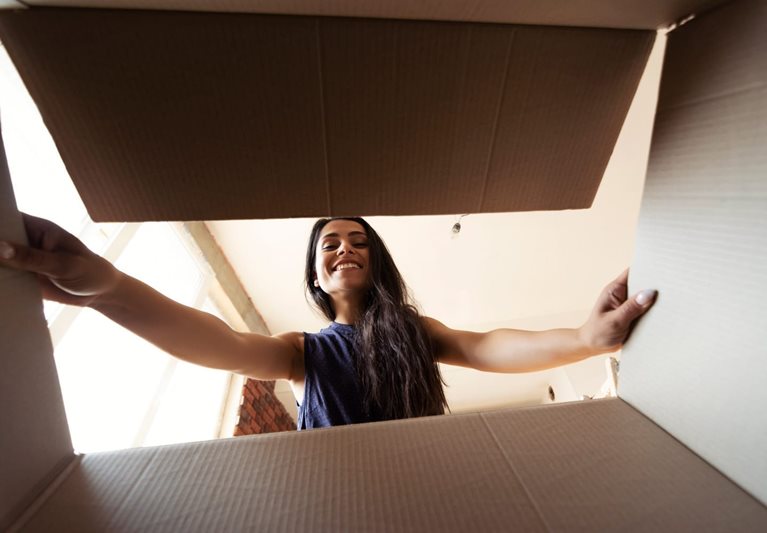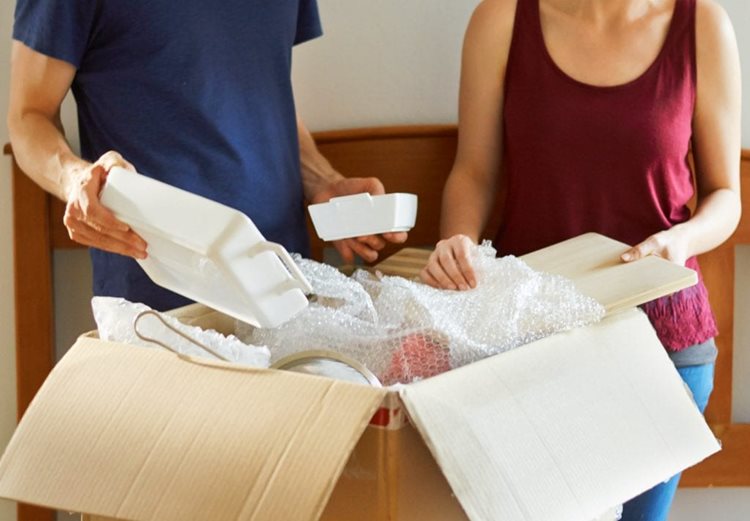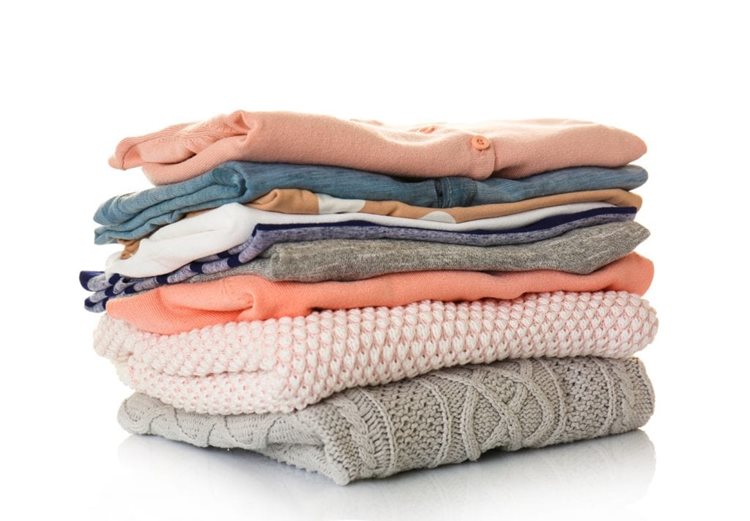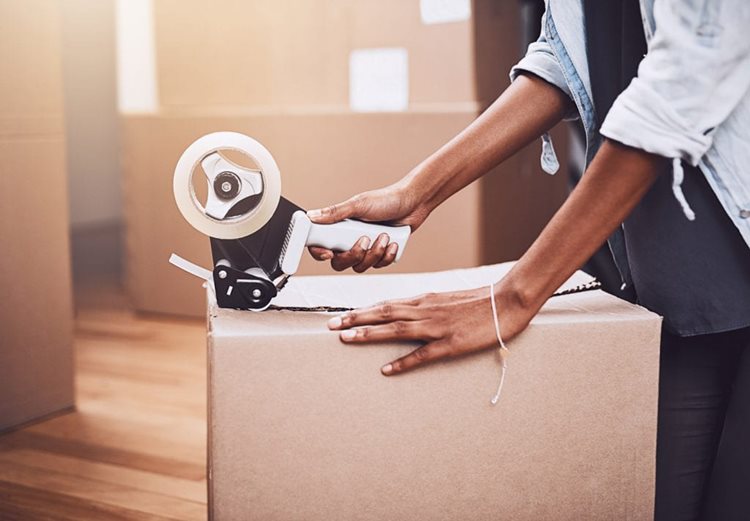
How To Pack Boxes for Moving
Packing Tips and Hacks
Before you fill that first box, consider these tips on how to pack boxes for moving, to help you protect your items, keep things organized, and make unpacking a little easier.
| Q: How soon before moving should I start packing? A: Despite your best intentions, you may end up packing the week before moving. But, if you can, moving pros say to start planning out your move six weeks before the big day. Then, reserve the last two to three weeks for packing. |
1. Start With the Right Tools.
Boxes, newspaper/packing paper, packing tape, and a marker. These are the obvious tools to have on hand. But there are a few other supplies to add to your toolkit:
- Box opener (in case you need to pop open a box you’ve sealed because you need an item you already packed)
- Bubble cushioning roll (to protect artwork and delicate breakables)
- Dust rag (to get rid of dust on your books or knick-knacks before you box them)
- Zipper storage bags (for miscellaneous “junk drawer” things like pens and buttons, as well as the hardware from disassembled furniture)
If you keep all of these items together in a shopping bag — especially that marker and the best packing tape for moving boxes — you and your family can move it room to room as you work together to pack, ensuring they won’t get lost in the chaos.
| Want moving boxes delivered to your door? Save time and money with fast, free shipping on all moving supplies. Order online now. |
2. Choose Your Moving Boxes Wisely.
When thinking about how to pack boxes for moving, picking the right boxes is an important step. Moving can come with all sorts of hidden costs, but you can take steps to make sure boxes aren’t one of them. If you don’t have any boxes from your last move (or they’re old and starting to get wimpy), you’re welcome to look around for free boxes. If you have to go with used boxes, though, visiting local businesses that stay far away from food and beverages will be your best bet. Grocery stores, restaurants, and liquor stores can attract insects like cockroaches and mites inside their boxes. Check out neighborhood sites like Nextdoor or Facebook Marketplace, instead, for folks trying to unload their recently used moving boxes and packing materials. Just be sure to inspect them carefully, as you don’t want to move with any bugs from these either.
Your best bet? If you have the budget, purchase moving boxes from a local moving company or hardware store — they can help you identify the size and quantity of boxes you’ll need. If you purchase the right number of small, medium, and wardrobe boxes, you’ll have more of a plan and waste less time trying to figure out how to make your belongings fit in random boxes. Don’t forget to dig out any appliance or electronic boxes you’ve saved, too. There’s nothing better than custom-built original packaging!
Need some help deciding the best boxes for moving? Check out our list of the best moving boxes — including options for those hard-to-pack items, like guitar boxes, poster tubes, and even bike boxes. When figuring out how to pack moving boxes, sometimes the most crucial step for specialty items like these is simply making sure you have the best box.

3. Prep the Boxes.
The next key step when considering how to pack boxes for moving is to build a strong foundation for your stuff by padding the bottom of each box. You can use bubble cushioning roll, crumpled paper, or a bath towel. This strengthens the box and adds an extra layer of protection if the bottom of the box gets wet or dirty during the move. Save more of that packing material to put on top of your stuff when you’ve filled the box. The box should feel firm when you push down on the top of it. If it feels squishy, reopen it and add some more packing material to fill it to capacity.
| Q: Should you completely fill moving boxes? A: It’s best to completely pack moving boxes, to prevent them from crushing under the weight of each other while stacking them in the moving truck (and possibly damaging the belongings inside). However, be careful not to overpack them to the point that they’re bursting or too heavy to carry — using clothing, newspaper, or packing paper can help fill the gaps without adding too much weight. |
4. Use Small Boxes for Heavy Items.
Heavy items like books, CDs, and canned goods are best for small boxes. Also consider using small boxes for easily grouped items like small picture frames, the miscellaneous stuff in your office desk drawers, or your silverware. For kitchen knives, use the knife guards, if available. Wrap fragile items like picture frames and knick-knacks in packing paper before putting them in the box. Got something extra fragile? Consider triple-wrapping it in bubble cushioning roll and taping down each layer. It may be a pain to unwrap, but you’ll appreciate it arriving in one piece!
Packing Books for Moving
Packing small and heavy is especially important when it comes to books. Those bricks will stack up in no time, making a medium or large box almost unmovable. Books should be packed flat, with the largest and heaviest books at the bottom. Once you’ve filled the box with books, use plenty of packing paper to fill the gaps. You could also use clothing or stuffed animals to fill the box — they’re lightweight and they need to be packed, too!
5. Use Medium Boxes As Catch-Alls.
Now it’s time to dig into some of the bigger items, like electronics, toys, pots and pans, and linens. Medium boxes can handle all of these — just make sure you get a good balance of weight in each box, so the contents don’t shift during the move.
When you’re packing your home entertainment electronics, wrap each component in packing paper and put cords, remotes, and game controllers in zipper storage bags. Since pots and pans are durable, you can skip the step of wrapping them. Just set them into the box and surround them with crumpled paper or kitchen towels to keep them from shifting in the box during the move.
The Art of Packing Dishes
Packing your plates and bowls doesn’t have to be the hardest task. You can get a special box for dishes (called a dish box) that has an extra layer of cardboard protection. You can also pick up small and large dish sleeves, made from a thin, foam-like material. Put one plate in each, stack them vertically, add crumpled-up packing paper to fill the gaps in the corners, and you’ve got yourself a nice, snug dish box.If you’re using a standard moving box, add some extra padding on the bottom and sides, and individually wrap each plate and bowl with packing paper, making sure there’s enough padding between them as you stack them vertically in the box. (Pro Tip: There’s no such thing as too much packing paper!) For items like teapots and vases, it’s important to put crumpled-up paper inside each item before you wrap them. It will help fortify these more delicate items during the move. Need more packing tips? Here’s a bit more from experts on the art of packing, in general.

How To Pack Clothes in Boxes for Moving
There are many methods for packing clothing, from using garbage bags to suitcases (the wheels are especially convenient for local and DIY moves!) to classic cardboard moving boxes to the dresser itself. But the best way to pack moving boxes when it comes to your closet? Check out the PODS Blog for a comprehensive look at how to pack clothes in boxes for moving, or keep reading for a couple of our favorite methods.
Wardrobe Boxes
Wardrobe boxes come with a hanging bar and are a perfect choice for coats, suits, dresses, and formal wear. That way, it’s an easy move from old closet to wardrobe box to new closet — it hardly feels like unpacking at all. You can also add small items on the bottom of the wardrobe box, like pillows, bathrobes, and slippers. Wardrobe boxes are also sometimes used for big, awkward items, like garden tools, the kids’ sports equipment, and tall artificial plants (or even some real plants, if you’re moving your plants), so don’t be afraid to get creative with it.
Vacuum Bags
Vacuum-sealed bags may just be the closest thing we have to magic in this world. Take that mountain of clothing on your bed (folded, of course), insert it into plastic vacuum-sealed bags, use a vacuum to suck all of the air out, and watch in awe as it condenses down to an extremely packable puck. You can easily stack these sealed bags into moving boxes or suitcases, and save a ton of space in the process.
| Q: How do you pack boxes for a move? A: When thinking about how to pack moving boxes, there are three main things to do: First, declutter. It doesn’t make sense to store or move with stuff that you don’t actually need. Second, gather all of your moving supplies, such as boxes, permanent markers for labeling, newspaper, and packing tape. And third, make sure you have the right boxes for your move — small boxes for heavy items, the original boxes for appliances (if you still have them), and specialty boxes for certain hard-to-pack items. |
How To Pack Shoe Boxes for Moving
If you save the boxes when you buy shoes, great! That’s the best way to protect them when moving. If not, though, you can still use a medium-sized box to transport all your sneakers, loafers, and sandals. Be sure to stuff the shoes with scrunched-up newspaper or tissue paper to prevent them from collapsing in on themselves, and then layer them intentionally — place the bulkiest, sturdiest shoes on the bottom (think: snow boots) and the most delicate, precious pairs on top (think: those strappy heels). Even if you just have a few shoeboxes on hand, it’s worth packing your favorite pairs separately in those boxes and loading the rest of your shoe shelf into a bigger box.

6. Prevent Leakage.
Undoubtedly, you’ll have some open containers in the bathroom and/or kitchen that you’ll need to move. Make sure each one is in its own zipper storage bag. That way, if something pops open during the move, you’ll have a small, contained mess instead of a big, goopy box. Take the extra step to write “This end up” and put arrows pointing upward on these boxes. That’ll increase the chances that your liquids will be handled with a bit more care.
7. Last But Not Least: Label Your Boxes.
The best way to pack boxes for moving always involves scrupulous labeling. Whether you’re the type who keeps a full inventory of each box, or you’re more of the “Hey, the toaster will fit perfectly in this box of board games” kind of packer, do yourself a favor and label as you go. At a minimum, put the name of the room where the contents of the box will live, and if there’s something extra important inside, don’t be shy to write it on the box. When you’re at your new home walking through a sea of boxes, you’ll be glad you did.
| Q: How should boxes be stacked when moving them? A: It’s intuitive, but important — the heaviest boxes should always go on the bottom. Similar to putting your eggs, bread, and bananas on top of the grocery bag (above the canned goods), you want to make sure your light and fragile items are on top, so they don’t risk getting crushed. |
Sofia Rivera is a Brooklyn-based lifestyle editor and frequent contributor to the PODS Blog. Her work has appeared in Boston magazine, Apartment Therapy, and more. You can most often find her redecorating her apartment, trying out a new recipe, or trekking all over the city.
Related Articles
Comments
Leave a Comment
Your email address will not be published. Required fields are marked *
